CHCDIV001: Formative Assessment on Workplace Diversity and Inclusion
VerifiedAdded on 2019/10/09
|23
|9279
|888
Homework Assignment
AI Summary
This document provides a comprehensive response to the CHCDIV001 assessment, focusing on working with diverse people in a professional setting. It addresses key concepts such as cultural competence, emphasizing the importance of self-reflection, understanding personal biases, and recognizing the value of diverse perspectives. The assignment explores the characteristics of an inclusive workplace, highlighting the need for acceptance, equal treatment, and transparent policies. Strategies to enhance workplace diversity and inclusiveness are detailed, including educating leaders, developing employees, and establishing anti-discrimination policies. The document further examines ensuring physical and emotional safety in the workplace, offering verbal and non-verbal strategies for respectful communication, and outlining techniques for building trusted relationships with clients. It also identifies communication barriers, particularly those related to language differences, and provides effective strategies for communicating with non-English speakers, including the use of interpreters. Finally, the assignment analyzes the impact of poor communication and cultural diversity on the workplace, providing practical advice to avoid misunderstandings and foster effective communication.
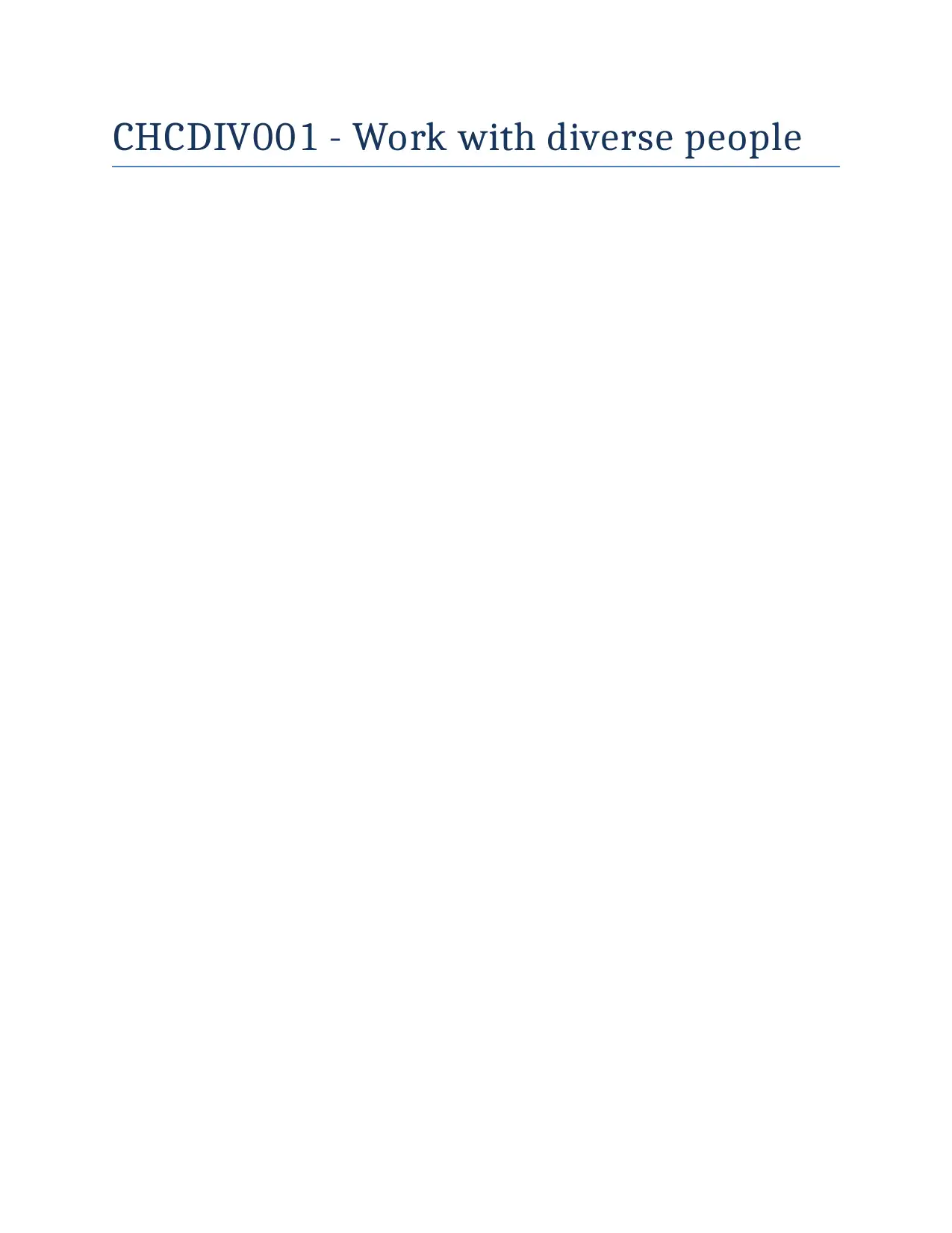
CHCDIV001 - Work with diverse people
Paraphrase This Document
Need a fresh take? Get an instant paraphrase of this document with our AI Paraphraser
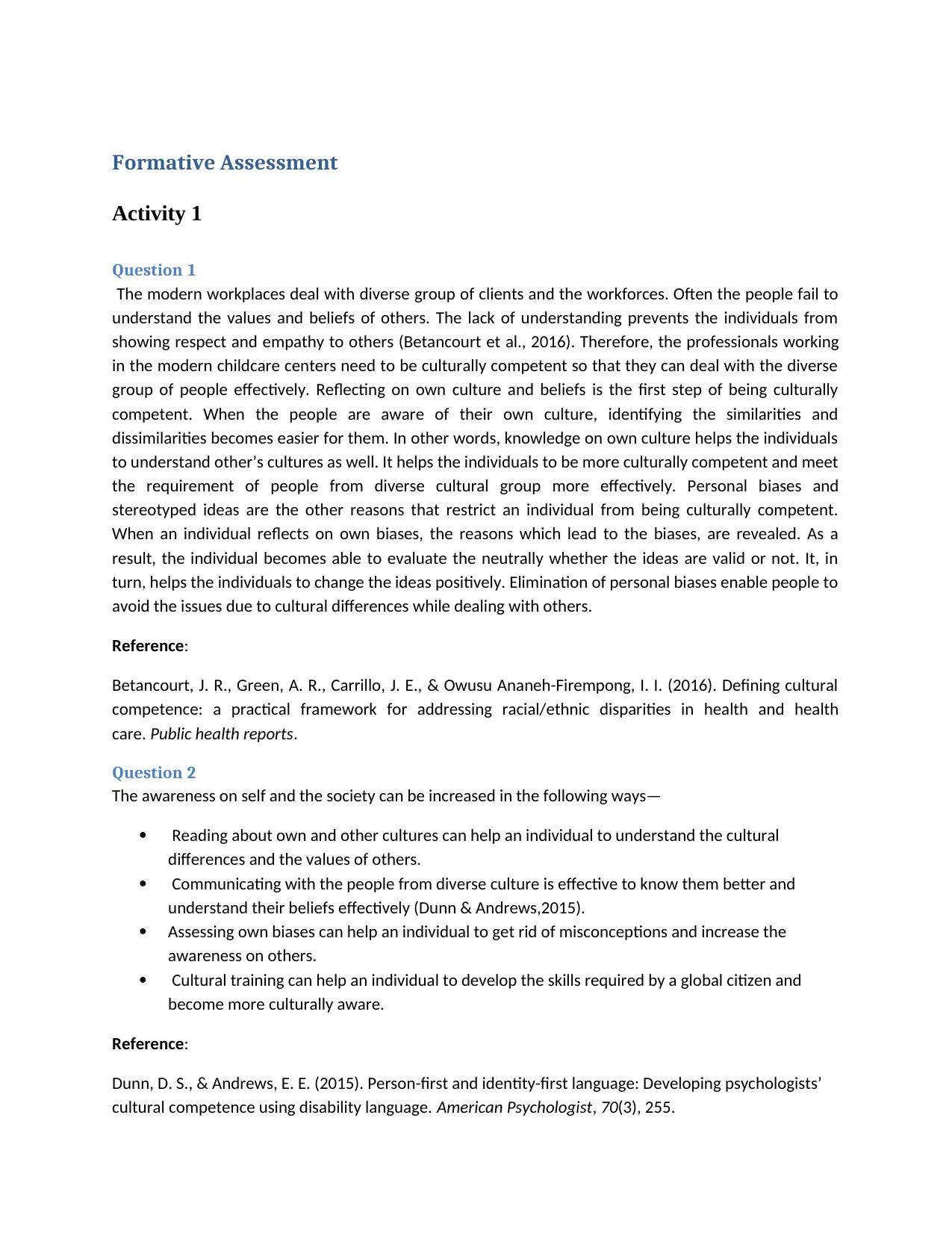
Formative Assessment
Activity 1
Question 1
The modern workplaces deal with diverse group of clients and the workforces. Often the people fail to
understand the values and beliefs of others. The lack of understanding prevents the individuals from
showing respect and empathy to others (Betancourt et al., 2016). Therefore, the professionals working
in the modern childcare centers need to be culturally competent so that they can deal with the diverse
group of people effectively. Reflecting on own culture and beliefs is the first step of being culturally
competent. When the people are aware of their own culture, identifying the similarities and
dissimilarities becomes easier for them. In other words, knowledge on own culture helps the individuals
to understand other’s cultures as well. It helps the individuals to be more culturally competent and meet
the requirement of people from diverse cultural group more effectively. Personal biases and
stereotyped ideas are the other reasons that restrict an individual from being culturally competent.
When an individual reflects on own biases, the reasons which lead to the biases, are revealed. As a
result, the individual becomes able to evaluate the neutrally whether the ideas are valid or not. It, in
turn, helps the individuals to change the ideas positively. Elimination of personal biases enable people to
avoid the issues due to cultural differences while dealing with others.
Reference:
Betancourt, J. R., Green, A. R., Carrillo, J. E., & Owusu Ananeh-Firempong, I. I. (2016). Defining cultural
competence: a practical framework for addressing racial/ethnic disparities in health and health
care. Public health reports.
Question 2
The awareness on self and the society can be increased in the following ways—
Reading about own and other cultures can help an individual to understand the cultural
differences and the values of others.
Communicating with the people from diverse culture is effective to know them better and
understand their beliefs effectively (Dunn & Andrews,2015).
Assessing own biases can help an individual to get rid of misconceptions and increase the
awareness on others.
Cultural training can help an individual to develop the skills required by a global citizen and
become more culturally aware.
Reference:
Dunn, D. S., & Andrews, E. E. (2015). Person-first and identity-first language: Developing psychologists’
cultural competence using disability language. American Psychologist, 70(3), 255.
Activity 1
Question 1
The modern workplaces deal with diverse group of clients and the workforces. Often the people fail to
understand the values and beliefs of others. The lack of understanding prevents the individuals from
showing respect and empathy to others (Betancourt et al., 2016). Therefore, the professionals working
in the modern childcare centers need to be culturally competent so that they can deal with the diverse
group of people effectively. Reflecting on own culture and beliefs is the first step of being culturally
competent. When the people are aware of their own culture, identifying the similarities and
dissimilarities becomes easier for them. In other words, knowledge on own culture helps the individuals
to understand other’s cultures as well. It helps the individuals to be more culturally competent and meet
the requirement of people from diverse cultural group more effectively. Personal biases and
stereotyped ideas are the other reasons that restrict an individual from being culturally competent.
When an individual reflects on own biases, the reasons which lead to the biases, are revealed. As a
result, the individual becomes able to evaluate the neutrally whether the ideas are valid or not. It, in
turn, helps the individuals to change the ideas positively. Elimination of personal biases enable people to
avoid the issues due to cultural differences while dealing with others.
Reference:
Betancourt, J. R., Green, A. R., Carrillo, J. E., & Owusu Ananeh-Firempong, I. I. (2016). Defining cultural
competence: a practical framework for addressing racial/ethnic disparities in health and health
care. Public health reports.
Question 2
The awareness on self and the society can be increased in the following ways—
Reading about own and other cultures can help an individual to understand the cultural
differences and the values of others.
Communicating with the people from diverse culture is effective to know them better and
understand their beliefs effectively (Dunn & Andrews,2015).
Assessing own biases can help an individual to get rid of misconceptions and increase the
awareness on others.
Cultural training can help an individual to develop the skills required by a global citizen and
become more culturally aware.
Reference:
Dunn, D. S., & Andrews, E. E. (2015). Person-first and identity-first language: Developing psychologists’
cultural competence using disability language. American Psychologist, 70(3), 255.
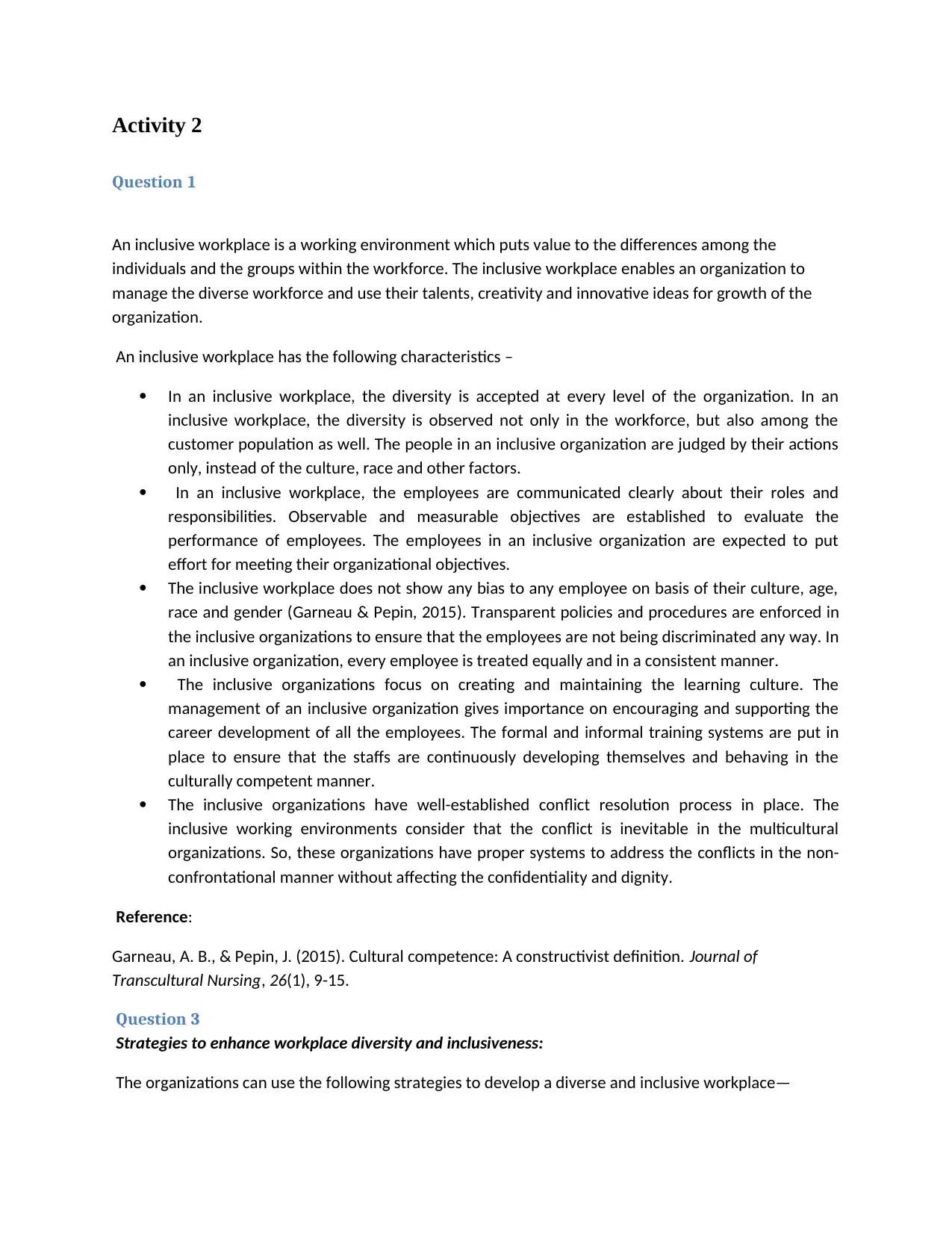
Activity 2
Question 1
An inclusive workplace is a working environment which puts value to the differences among the
individuals and the groups within the workforce. The inclusive workplace enables an organization to
manage the diverse workforce and use their talents, creativity and innovative ideas for growth of the
organization.
An inclusive workplace has the following characteristics –
In an inclusive workplace, the diversity is accepted at every level of the organization. In an
inclusive workplace, the diversity is observed not only in the workforce, but also among the
customer population as well. The people in an inclusive organization are judged by their actions
only, instead of the culture, race and other factors.
In an inclusive workplace, the employees are communicated clearly about their roles and
responsibilities. Observable and measurable objectives are established to evaluate the
performance of employees. The employees in an inclusive organization are expected to put
effort for meeting their organizational objectives.
The inclusive workplace does not show any bias to any employee on basis of their culture, age,
race and gender (Garneau & Pepin, 2015). Transparent policies and procedures are enforced in
the inclusive organizations to ensure that the employees are not being discriminated any way. In
an inclusive organization, every employee is treated equally and in a consistent manner.
The inclusive organizations focus on creating and maintaining the learning culture. The
management of an inclusive organization gives importance on encouraging and supporting the
career development of all the employees. The formal and informal training systems are put in
place to ensure that the staffs are continuously developing themselves and behaving in the
culturally competent manner.
The inclusive organizations have well-established conflict resolution process in place. The
inclusive working environments consider that the conflict is inevitable in the multicultural
organizations. So, these organizations have proper systems to address the conflicts in the non-
confrontational manner without affecting the confidentiality and dignity.
Reference:
Garneau, A. B., & Pepin, J. (2015). Cultural competence: A constructivist definition. Journal of
Transcultural Nursing, 26(1), 9-15.
Question 3
Strategies to enhance workplace diversity and inclusiveness:
The organizations can use the following strategies to develop a diverse and inclusive workplace—
Question 1
An inclusive workplace is a working environment which puts value to the differences among the
individuals and the groups within the workforce. The inclusive workplace enables an organization to
manage the diverse workforce and use their talents, creativity and innovative ideas for growth of the
organization.
An inclusive workplace has the following characteristics –
In an inclusive workplace, the diversity is accepted at every level of the organization. In an
inclusive workplace, the diversity is observed not only in the workforce, but also among the
customer population as well. The people in an inclusive organization are judged by their actions
only, instead of the culture, race and other factors.
In an inclusive workplace, the employees are communicated clearly about their roles and
responsibilities. Observable and measurable objectives are established to evaluate the
performance of employees. The employees in an inclusive organization are expected to put
effort for meeting their organizational objectives.
The inclusive workplace does not show any bias to any employee on basis of their culture, age,
race and gender (Garneau & Pepin, 2015). Transparent policies and procedures are enforced in
the inclusive organizations to ensure that the employees are not being discriminated any way. In
an inclusive organization, every employee is treated equally and in a consistent manner.
The inclusive organizations focus on creating and maintaining the learning culture. The
management of an inclusive organization gives importance on encouraging and supporting the
career development of all the employees. The formal and informal training systems are put in
place to ensure that the staffs are continuously developing themselves and behaving in the
culturally competent manner.
The inclusive organizations have well-established conflict resolution process in place. The
inclusive working environments consider that the conflict is inevitable in the multicultural
organizations. So, these organizations have proper systems to address the conflicts in the non-
confrontational manner without affecting the confidentiality and dignity.
Reference:
Garneau, A. B., & Pepin, J. (2015). Cultural competence: A constructivist definition. Journal of
Transcultural Nursing, 26(1), 9-15.
Question 3
Strategies to enhance workplace diversity and inclusiveness:
The organizations can use the following strategies to develop a diverse and inclusive workplace—
⊘ This is a preview!⊘
Do you want full access?
Subscribe today to unlock all pages.

Trusted by 1+ million students worldwide
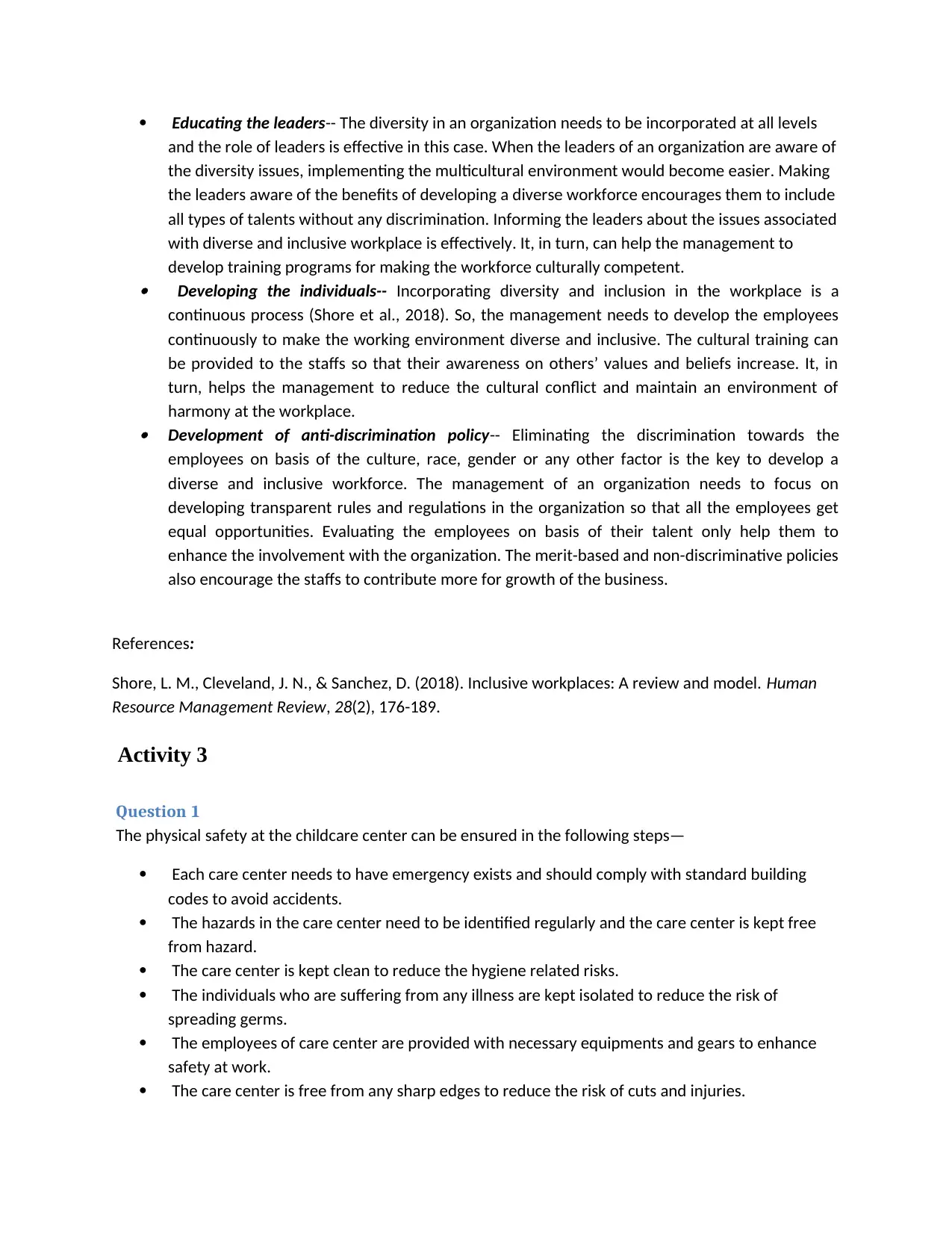
Educating the leaders-- The diversity in an organization needs to be incorporated at all levels
and the role of leaders is effective in this case. When the leaders of an organization are aware of
the diversity issues, implementing the multicultural environment would become easier. Making
the leaders aware of the benefits of developing a diverse workforce encourages them to include
all types of talents without any discrimination. Informing the leaders about the issues associated
with diverse and inclusive workplace is effectively. It, in turn, can help the management to
develop training programs for making the workforce culturally competent.
Developing the individuals-- Incorporating diversity and inclusion in the workplace is a
continuous process (Shore et al., 2018). So, the management needs to develop the employees
continuously to make the working environment diverse and inclusive. The cultural training can
be provided to the staffs so that their awareness on others’ values and beliefs increase. It, in
turn, helps the management to reduce the cultural conflict and maintain an environment of
harmony at the workplace.
Development of anti-discrimination policy-- Eliminating the discrimination towards the
employees on basis of the culture, race, gender or any other factor is the key to develop a
diverse and inclusive workforce. The management of an organization needs to focus on
developing transparent rules and regulations in the organization so that all the employees get
equal opportunities. Evaluating the employees on basis of their talent only help them to
enhance the involvement with the organization. The merit-based and non-discriminative policies
also encourage the staffs to contribute more for growth of the business.
References:
Shore, L. M., Cleveland, J. N., & Sanchez, D. (2018). Inclusive workplaces: A review and model. Human
Resource Management Review, 28(2), 176-189.
Activity 3
Question 1
The physical safety at the childcare center can be ensured in the following steps—
Each care center needs to have emergency exists and should comply with standard building
codes to avoid accidents.
The hazards in the care center need to be identified regularly and the care center is kept free
from hazard.
The care center is kept clean to reduce the hygiene related risks.
The individuals who are suffering from any illness are kept isolated to reduce the risk of
spreading germs.
The employees of care center are provided with necessary equipments and gears to enhance
safety at work.
The care center is free from any sharp edges to reduce the risk of cuts and injuries.
and the role of leaders is effective in this case. When the leaders of an organization are aware of
the diversity issues, implementing the multicultural environment would become easier. Making
the leaders aware of the benefits of developing a diverse workforce encourages them to include
all types of talents without any discrimination. Informing the leaders about the issues associated
with diverse and inclusive workplace is effectively. It, in turn, can help the management to
develop training programs for making the workforce culturally competent.
Developing the individuals-- Incorporating diversity and inclusion in the workplace is a
continuous process (Shore et al., 2018). So, the management needs to develop the employees
continuously to make the working environment diverse and inclusive. The cultural training can
be provided to the staffs so that their awareness on others’ values and beliefs increase. It, in
turn, helps the management to reduce the cultural conflict and maintain an environment of
harmony at the workplace.
Development of anti-discrimination policy-- Eliminating the discrimination towards the
employees on basis of the culture, race, gender or any other factor is the key to develop a
diverse and inclusive workforce. The management of an organization needs to focus on
developing transparent rules and regulations in the organization so that all the employees get
equal opportunities. Evaluating the employees on basis of their talent only help them to
enhance the involvement with the organization. The merit-based and non-discriminative policies
also encourage the staffs to contribute more for growth of the business.
References:
Shore, L. M., Cleveland, J. N., & Sanchez, D. (2018). Inclusive workplaces: A review and model. Human
Resource Management Review, 28(2), 176-189.
Activity 3
Question 1
The physical safety at the childcare center can be ensured in the following steps—
Each care center needs to have emergency exists and should comply with standard building
codes to avoid accidents.
The hazards in the care center need to be identified regularly and the care center is kept free
from hazard.
The care center is kept clean to reduce the hygiene related risks.
The individuals who are suffering from any illness are kept isolated to reduce the risk of
spreading germs.
The employees of care center are provided with necessary equipments and gears to enhance
safety at work.
The care center is free from any sharp edges to reduce the risk of cuts and injuries.
Paraphrase This Document
Need a fresh take? Get an instant paraphrase of this document with our AI Paraphraser
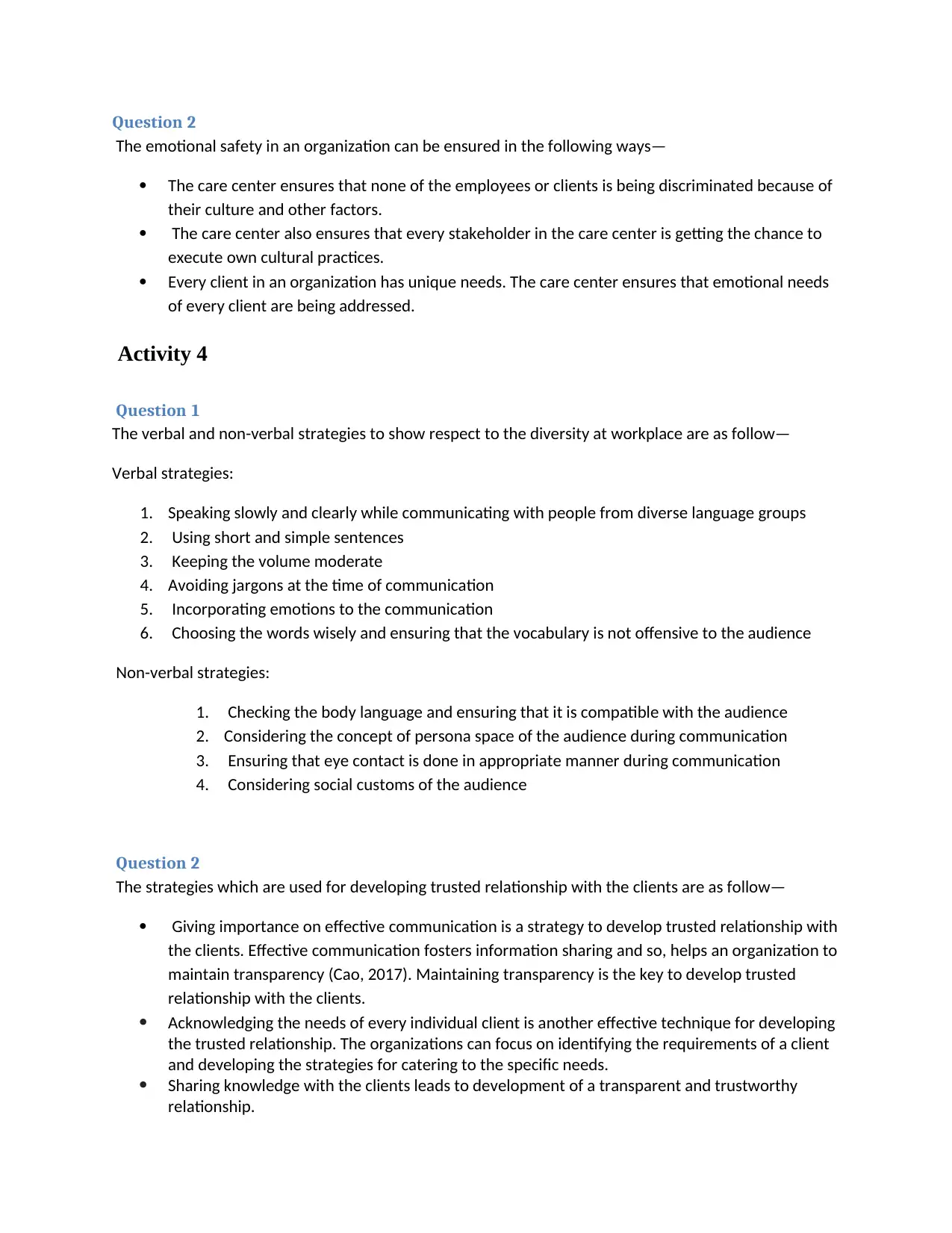
Question 2
The emotional safety in an organization can be ensured in the following ways—
The care center ensures that none of the employees or clients is being discriminated because of
their culture and other factors.
The care center also ensures that every stakeholder in the care center is getting the chance to
execute own cultural practices.
Every client in an organization has unique needs. The care center ensures that emotional needs
of every client are being addressed.
Activity 4
Question 1
The verbal and non-verbal strategies to show respect to the diversity at workplace are as follow—
Verbal strategies:
1. Speaking slowly and clearly while communicating with people from diverse language groups
2. Using short and simple sentences
3. Keeping the volume moderate
4. Avoiding jargons at the time of communication
5. Incorporating emotions to the communication
6. Choosing the words wisely and ensuring that the vocabulary is not offensive to the audience
Non-verbal strategies:
1. Checking the body language and ensuring that it is compatible with the audience
2. Considering the concept of persona space of the audience during communication
3. Ensuring that eye contact is done in appropriate manner during communication
4. Considering social customs of the audience
Question 2
The strategies which are used for developing trusted relationship with the clients are as follow—
Giving importance on effective communication is a strategy to develop trusted relationship with
the clients. Effective communication fosters information sharing and so, helps an organization to
maintain transparency (Cao, 2017). Maintaining transparency is the key to develop trusted
relationship with the clients.
Acknowledging the needs of every individual client is another effective technique for developing
the trusted relationship. The organizations can focus on identifying the requirements of a client
and developing the strategies for catering to the specific needs.
Sharing knowledge with the clients leads to development of a transparent and trustworthy
relationship.
The emotional safety in an organization can be ensured in the following ways—
The care center ensures that none of the employees or clients is being discriminated because of
their culture and other factors.
The care center also ensures that every stakeholder in the care center is getting the chance to
execute own cultural practices.
Every client in an organization has unique needs. The care center ensures that emotional needs
of every client are being addressed.
Activity 4
Question 1
The verbal and non-verbal strategies to show respect to the diversity at workplace are as follow—
Verbal strategies:
1. Speaking slowly and clearly while communicating with people from diverse language groups
2. Using short and simple sentences
3. Keeping the volume moderate
4. Avoiding jargons at the time of communication
5. Incorporating emotions to the communication
6. Choosing the words wisely and ensuring that the vocabulary is not offensive to the audience
Non-verbal strategies:
1. Checking the body language and ensuring that it is compatible with the audience
2. Considering the concept of persona space of the audience during communication
3. Ensuring that eye contact is done in appropriate manner during communication
4. Considering social customs of the audience
Question 2
The strategies which are used for developing trusted relationship with the clients are as follow—
Giving importance on effective communication is a strategy to develop trusted relationship with
the clients. Effective communication fosters information sharing and so, helps an organization to
maintain transparency (Cao, 2017). Maintaining transparency is the key to develop trusted
relationship with the clients.
Acknowledging the needs of every individual client is another effective technique for developing
the trusted relationship. The organizations can focus on identifying the requirements of a client
and developing the strategies for catering to the specific needs.
Sharing knowledge with the clients leads to development of a transparent and trustworthy
relationship.
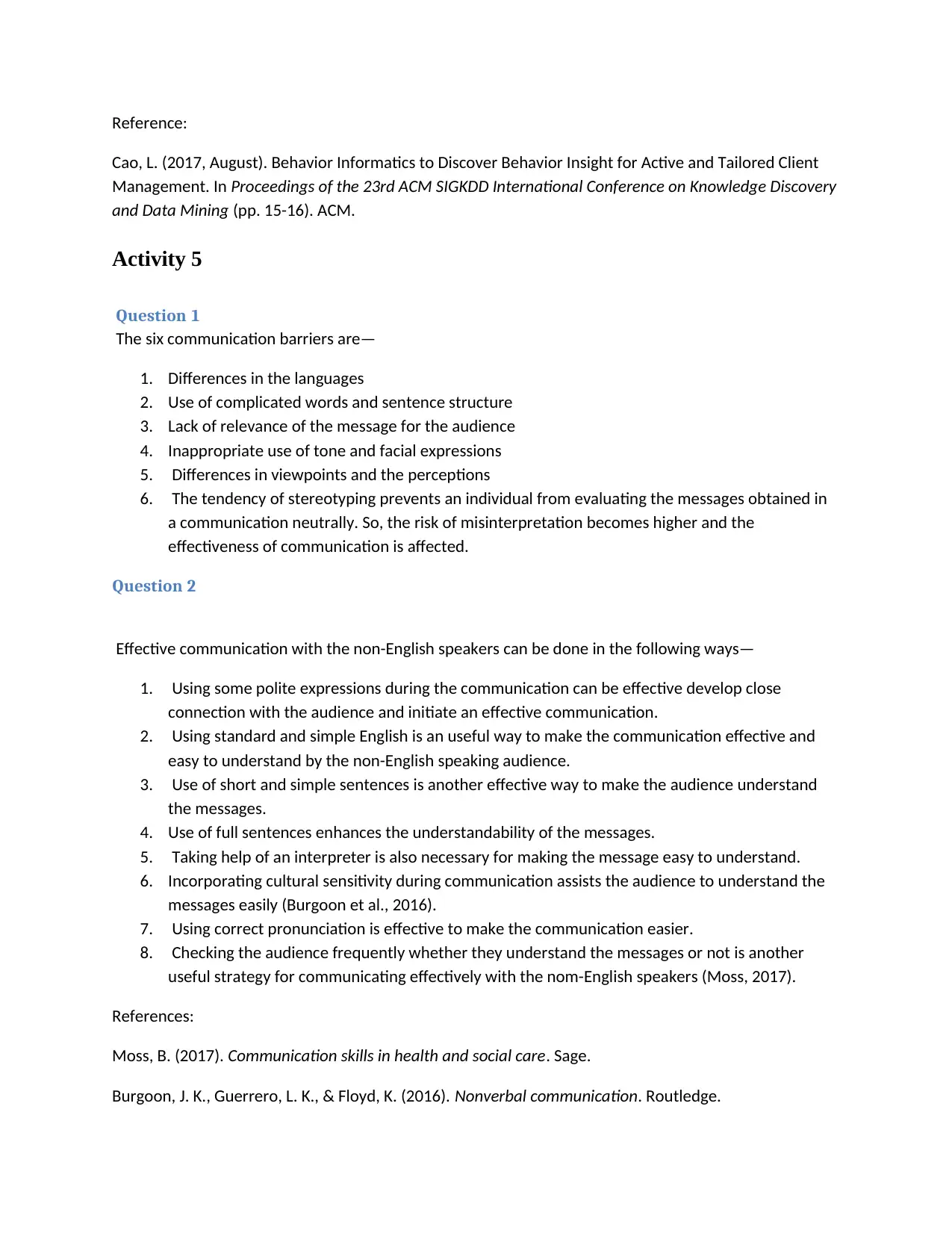
Reference:
Cao, L. (2017, August). Behavior Informatics to Discover Behavior Insight for Active and Tailored Client
Management. In Proceedings of the 23rd ACM SIGKDD International Conference on Knowledge Discovery
and Data Mining (pp. 15-16). ACM.
Activity 5
Question 1
The six communication barriers are—
1. Differences in the languages
2. Use of complicated words and sentence structure
3. Lack of relevance of the message for the audience
4. Inappropriate use of tone and facial expressions
5. Differences in viewpoints and the perceptions
6. The tendency of stereotyping prevents an individual from evaluating the messages obtained in
a communication neutrally. So, the risk of misinterpretation becomes higher and the
effectiveness of communication is affected.
Question 2
Effective communication with the non-English speakers can be done in the following ways—
1. Using some polite expressions during the communication can be effective develop close
connection with the audience and initiate an effective communication.
2. Using standard and simple English is an useful way to make the communication effective and
easy to understand by the non-English speaking audience.
3. Use of short and simple sentences is another effective way to make the audience understand
the messages.
4. Use of full sentences enhances the understandability of the messages.
5. Taking help of an interpreter is also necessary for making the message easy to understand.
6. Incorporating cultural sensitivity during communication assists the audience to understand the
messages easily (Burgoon et al., 2016).
7. Using correct pronunciation is effective to make the communication easier.
8. Checking the audience frequently whether they understand the messages or not is another
useful strategy for communicating effectively with the nom-English speakers (Moss, 2017).
References:
Moss, B. (2017). Communication skills in health and social care. Sage.
Burgoon, J. K., Guerrero, L. K., & Floyd, K. (2016). Nonverbal communication. Routledge.
Cao, L. (2017, August). Behavior Informatics to Discover Behavior Insight for Active and Tailored Client
Management. In Proceedings of the 23rd ACM SIGKDD International Conference on Knowledge Discovery
and Data Mining (pp. 15-16). ACM.
Activity 5
Question 1
The six communication barriers are—
1. Differences in the languages
2. Use of complicated words and sentence structure
3. Lack of relevance of the message for the audience
4. Inappropriate use of tone and facial expressions
5. Differences in viewpoints and the perceptions
6. The tendency of stereotyping prevents an individual from evaluating the messages obtained in
a communication neutrally. So, the risk of misinterpretation becomes higher and the
effectiveness of communication is affected.
Question 2
Effective communication with the non-English speakers can be done in the following ways—
1. Using some polite expressions during the communication can be effective develop close
connection with the audience and initiate an effective communication.
2. Using standard and simple English is an useful way to make the communication effective and
easy to understand by the non-English speaking audience.
3. Use of short and simple sentences is another effective way to make the audience understand
the messages.
4. Use of full sentences enhances the understandability of the messages.
5. Taking help of an interpreter is also necessary for making the message easy to understand.
6. Incorporating cultural sensitivity during communication assists the audience to understand the
messages easily (Burgoon et al., 2016).
7. Using correct pronunciation is effective to make the communication easier.
8. Checking the audience frequently whether they understand the messages or not is another
useful strategy for communicating effectively with the nom-English speakers (Moss, 2017).
References:
Moss, B. (2017). Communication skills in health and social care. Sage.
Burgoon, J. K., Guerrero, L. K., & Floyd, K. (2016). Nonverbal communication. Routledge.
⊘ This is a preview!⊘
Do you want full access?
Subscribe today to unlock all pages.

Trusted by 1+ million students worldwide
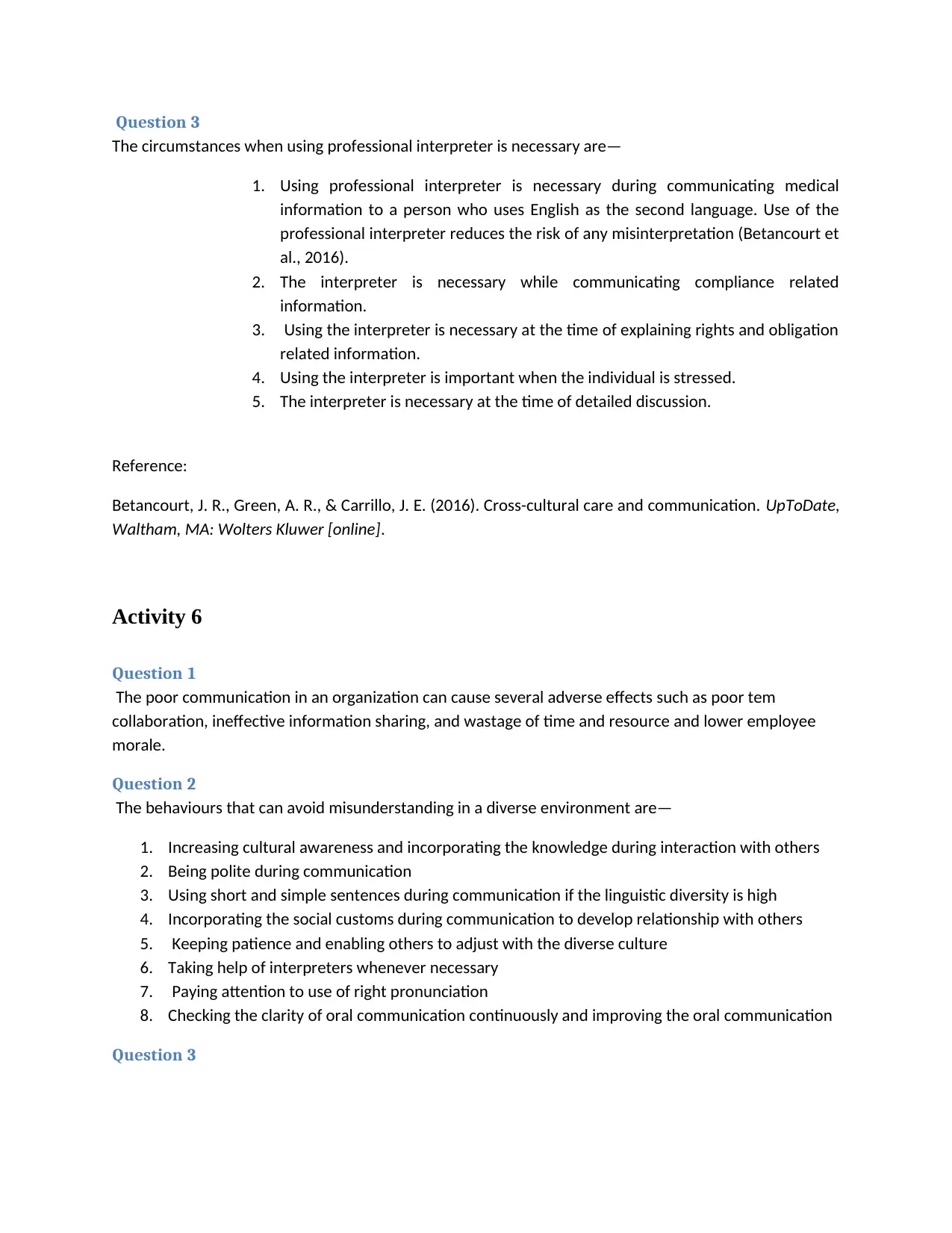
Question 3
The circumstances when using professional interpreter is necessary are—
1. Using professional interpreter is necessary during communicating medical
information to a person who uses English as the second language. Use of the
professional interpreter reduces the risk of any misinterpretation (Betancourt et
al., 2016).
2. The interpreter is necessary while communicating compliance related
information.
3. Using the interpreter is necessary at the time of explaining rights and obligation
related information.
4. Using the interpreter is important when the individual is stressed.
5. The interpreter is necessary at the time of detailed discussion.
Reference:
Betancourt, J. R., Green, A. R., & Carrillo, J. E. (2016). Cross-cultural care and communication. UpToDate,
Waltham, MA: Wolters Kluwer [online].
Activity 6
Question 1
The poor communication in an organization can cause several adverse effects such as poor tem
collaboration, ineffective information sharing, and wastage of time and resource and lower employee
morale.
Question 2
The behaviours that can avoid misunderstanding in a diverse environment are—
1. Increasing cultural awareness and incorporating the knowledge during interaction with others
2. Being polite during communication
3. Using short and simple sentences during communication if the linguistic diversity is high
4. Incorporating the social customs during communication to develop relationship with others
5. Keeping patience and enabling others to adjust with the diverse culture
6. Taking help of interpreters whenever necessary
7. Paying attention to use of right pronunciation
8. Checking the clarity of oral communication continuously and improving the oral communication
Question 3
The circumstances when using professional interpreter is necessary are—
1. Using professional interpreter is necessary during communicating medical
information to a person who uses English as the second language. Use of the
professional interpreter reduces the risk of any misinterpretation (Betancourt et
al., 2016).
2. The interpreter is necessary while communicating compliance related
information.
3. Using the interpreter is necessary at the time of explaining rights and obligation
related information.
4. Using the interpreter is important when the individual is stressed.
5. The interpreter is necessary at the time of detailed discussion.
Reference:
Betancourt, J. R., Green, A. R., & Carrillo, J. E. (2016). Cross-cultural care and communication. UpToDate,
Waltham, MA: Wolters Kluwer [online].
Activity 6
Question 1
The poor communication in an organization can cause several adverse effects such as poor tem
collaboration, ineffective information sharing, and wastage of time and resource and lower employee
morale.
Question 2
The behaviours that can avoid misunderstanding in a diverse environment are—
1. Increasing cultural awareness and incorporating the knowledge during interaction with others
2. Being polite during communication
3. Using short and simple sentences during communication if the linguistic diversity is high
4. Incorporating the social customs during communication to develop relationship with others
5. Keeping patience and enabling others to adjust with the diverse culture
6. Taking help of interpreters whenever necessary
7. Paying attention to use of right pronunciation
8. Checking the clarity of oral communication continuously and improving the oral communication
Question 3
Paraphrase This Document
Need a fresh take? Get an instant paraphrase of this document with our AI Paraphraser
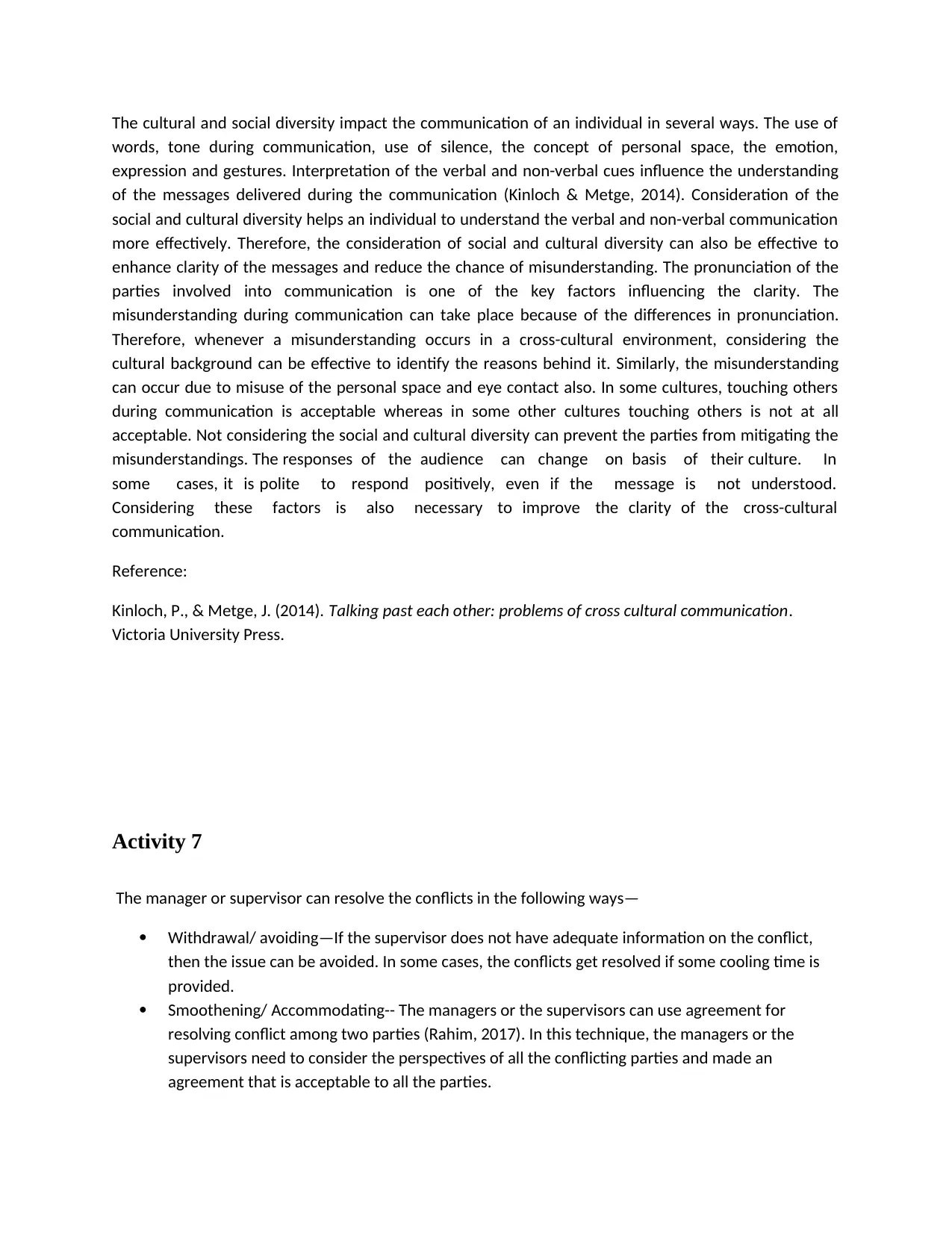
The cultural and social diversity impact the communication of an individual in several ways. The use of
words, tone during communication, use of silence, the concept of personal space, the emotion,
expression and gestures. Interpretation of the verbal and non-verbal cues influence the understanding
of the messages delivered during the communication (Kinloch & Metge, 2014). Consideration of the
social and cultural diversity helps an individual to understand the verbal and non-verbal communication
more effectively. Therefore, the consideration of social and cultural diversity can also be effective to
enhance clarity of the messages and reduce the chance of misunderstanding. The pronunciation of the
parties involved into communication is one of the key factors influencing the clarity. The
misunderstanding during communication can take place because of the differences in pronunciation.
Therefore, whenever a misunderstanding occurs in a cross-cultural environment, considering the
cultural background can be effective to identify the reasons behind it. Similarly, the misunderstanding
can occur due to misuse of the personal space and eye contact also. In some cultures, touching others
during communication is acceptable whereas in some other cultures touching others is not at all
acceptable. Not considering the social and cultural diversity can prevent the parties from mitigating the
misunderstandings. The responses of the audience can change on basis of their culture. In
some cases, it is polite to respond positively, even if the message is not understood.
Considering these factors is also necessary to improve the clarity of the cross-cultural
communication.
Reference:
Kinloch, P., & Metge, J. (2014). Talking past each other: problems of cross cultural communication.
Victoria University Press.
Activity 7
The manager or supervisor can resolve the conflicts in the following ways—
Withdrawal/ avoiding—If the supervisor does not have adequate information on the conflict,
then the issue can be avoided. In some cases, the conflicts get resolved if some cooling time is
provided.
Smoothening/ Accommodating-- The managers or the supervisors can use agreement for
resolving conflict among two parties (Rahim, 2017). In this technique, the managers or the
supervisors need to consider the perspectives of all the conflicting parties and made an
agreement that is acceptable to all the parties.
words, tone during communication, use of silence, the concept of personal space, the emotion,
expression and gestures. Interpretation of the verbal and non-verbal cues influence the understanding
of the messages delivered during the communication (Kinloch & Metge, 2014). Consideration of the
social and cultural diversity helps an individual to understand the verbal and non-verbal communication
more effectively. Therefore, the consideration of social and cultural diversity can also be effective to
enhance clarity of the messages and reduce the chance of misunderstanding. The pronunciation of the
parties involved into communication is one of the key factors influencing the clarity. The
misunderstanding during communication can take place because of the differences in pronunciation.
Therefore, whenever a misunderstanding occurs in a cross-cultural environment, considering the
cultural background can be effective to identify the reasons behind it. Similarly, the misunderstanding
can occur due to misuse of the personal space and eye contact also. In some cultures, touching others
during communication is acceptable whereas in some other cultures touching others is not at all
acceptable. Not considering the social and cultural diversity can prevent the parties from mitigating the
misunderstandings. The responses of the audience can change on basis of their culture. In
some cases, it is polite to respond positively, even if the message is not understood.
Considering these factors is also necessary to improve the clarity of the cross-cultural
communication.
Reference:
Kinloch, P., & Metge, J. (2014). Talking past each other: problems of cross cultural communication.
Victoria University Press.
Activity 7
The manager or supervisor can resolve the conflicts in the following ways—
Withdrawal/ avoiding—If the supervisor does not have adequate information on the conflict,
then the issue can be avoided. In some cases, the conflicts get resolved if some cooling time is
provided.
Smoothening/ Accommodating-- The managers or the supervisors can use agreement for
resolving conflict among two parties (Rahim, 2017). In this technique, the managers or the
supervisors need to consider the perspectives of all the conflicting parties and made an
agreement that is acceptable to all the parties.
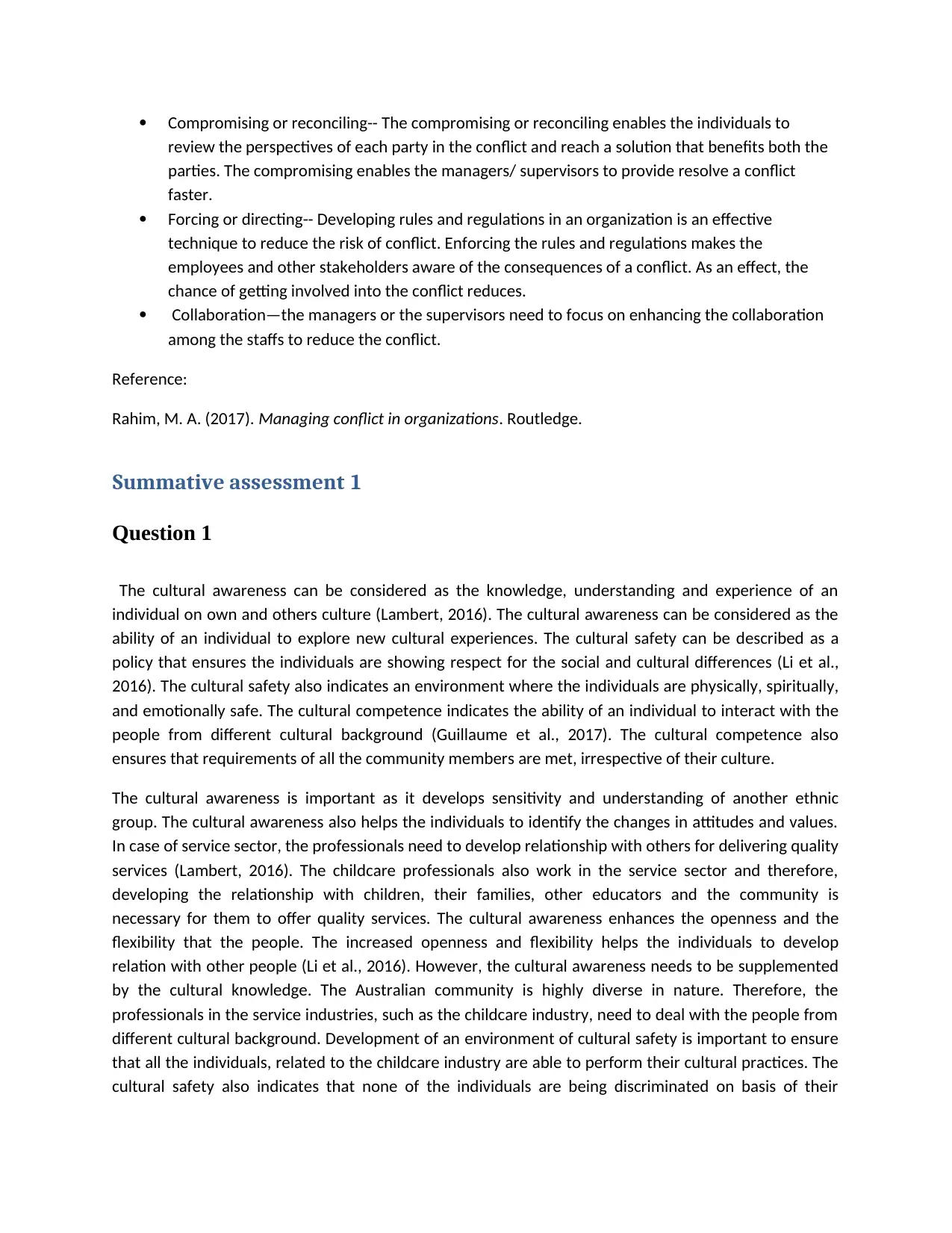
Compromising or reconciling-- The compromising or reconciling enables the individuals to
review the perspectives of each party in the conflict and reach a solution that benefits both the
parties. The compromising enables the managers/ supervisors to provide resolve a conflict
faster.
Forcing or directing-- Developing rules and regulations in an organization is an effective
technique to reduce the risk of conflict. Enforcing the rules and regulations makes the
employees and other stakeholders aware of the consequences of a conflict. As an effect, the
chance of getting involved into the conflict reduces.
Collaboration—the managers or the supervisors need to focus on enhancing the collaboration
among the staffs to reduce the conflict.
Reference:
Rahim, M. A. (2017). Managing conflict in organizations. Routledge.
Summative assessment 1
Question 1
The cultural awareness can be considered as the knowledge, understanding and experience of an
individual on own and others culture (Lambert, 2016). The cultural awareness can be considered as the
ability of an individual to explore new cultural experiences. The cultural safety can be described as a
policy that ensures the individuals are showing respect for the social and cultural differences (Li et al.,
2016). The cultural safety also indicates an environment where the individuals are physically, spiritually,
and emotionally safe. The cultural competence indicates the ability of an individual to interact with the
people from different cultural background (Guillaume et al., 2017). The cultural competence also
ensures that requirements of all the community members are met, irrespective of their culture.
The cultural awareness is important as it develops sensitivity and understanding of another ethnic
group. The cultural awareness also helps the individuals to identify the changes in attitudes and values.
In case of service sector, the professionals need to develop relationship with others for delivering quality
services (Lambert, 2016). The childcare professionals also work in the service sector and therefore,
developing the relationship with children, their families, other educators and the community is
necessary for them to offer quality services. The cultural awareness enhances the openness and the
flexibility that the people. The increased openness and flexibility helps the individuals to develop
relation with other people (Li et al., 2016). However, the cultural awareness needs to be supplemented
by the cultural knowledge. The Australian community is highly diverse in nature. Therefore, the
professionals in the service industries, such as the childcare industry, need to deal with the people from
different cultural background. Development of an environment of cultural safety is important to ensure
that all the individuals, related to the childcare industry are able to perform their cultural practices. The
cultural safety also indicates that none of the individuals are being discriminated on basis of their
review the perspectives of each party in the conflict and reach a solution that benefits both the
parties. The compromising enables the managers/ supervisors to provide resolve a conflict
faster.
Forcing or directing-- Developing rules and regulations in an organization is an effective
technique to reduce the risk of conflict. Enforcing the rules and regulations makes the
employees and other stakeholders aware of the consequences of a conflict. As an effect, the
chance of getting involved into the conflict reduces.
Collaboration—the managers or the supervisors need to focus on enhancing the collaboration
among the staffs to reduce the conflict.
Reference:
Rahim, M. A. (2017). Managing conflict in organizations. Routledge.
Summative assessment 1
Question 1
The cultural awareness can be considered as the knowledge, understanding and experience of an
individual on own and others culture (Lambert, 2016). The cultural awareness can be considered as the
ability of an individual to explore new cultural experiences. The cultural safety can be described as a
policy that ensures the individuals are showing respect for the social and cultural differences (Li et al.,
2016). The cultural safety also indicates an environment where the individuals are physically, spiritually,
and emotionally safe. The cultural competence indicates the ability of an individual to interact with the
people from different cultural background (Guillaume et al., 2017). The cultural competence also
ensures that requirements of all the community members are met, irrespective of their culture.
The cultural awareness is important as it develops sensitivity and understanding of another ethnic
group. The cultural awareness also helps the individuals to identify the changes in attitudes and values.
In case of service sector, the professionals need to develop relationship with others for delivering quality
services (Lambert, 2016). The childcare professionals also work in the service sector and therefore,
developing the relationship with children, their families, other educators and the community is
necessary for them to offer quality services. The cultural awareness enhances the openness and the
flexibility that the people. The increased openness and flexibility helps the individuals to develop
relation with other people (Li et al., 2016). However, the cultural awareness needs to be supplemented
by the cultural knowledge. The Australian community is highly diverse in nature. Therefore, the
professionals in the service industries, such as the childcare industry, need to deal with the people from
different cultural background. Development of an environment of cultural safety is important to ensure
that all the individuals, related to the childcare industry are able to perform their cultural practices. The
cultural safety also indicates that none of the individuals are being discriminated on basis of their
⊘ This is a preview!⊘
Do you want full access?
Subscribe today to unlock all pages.

Trusted by 1+ million students worldwide
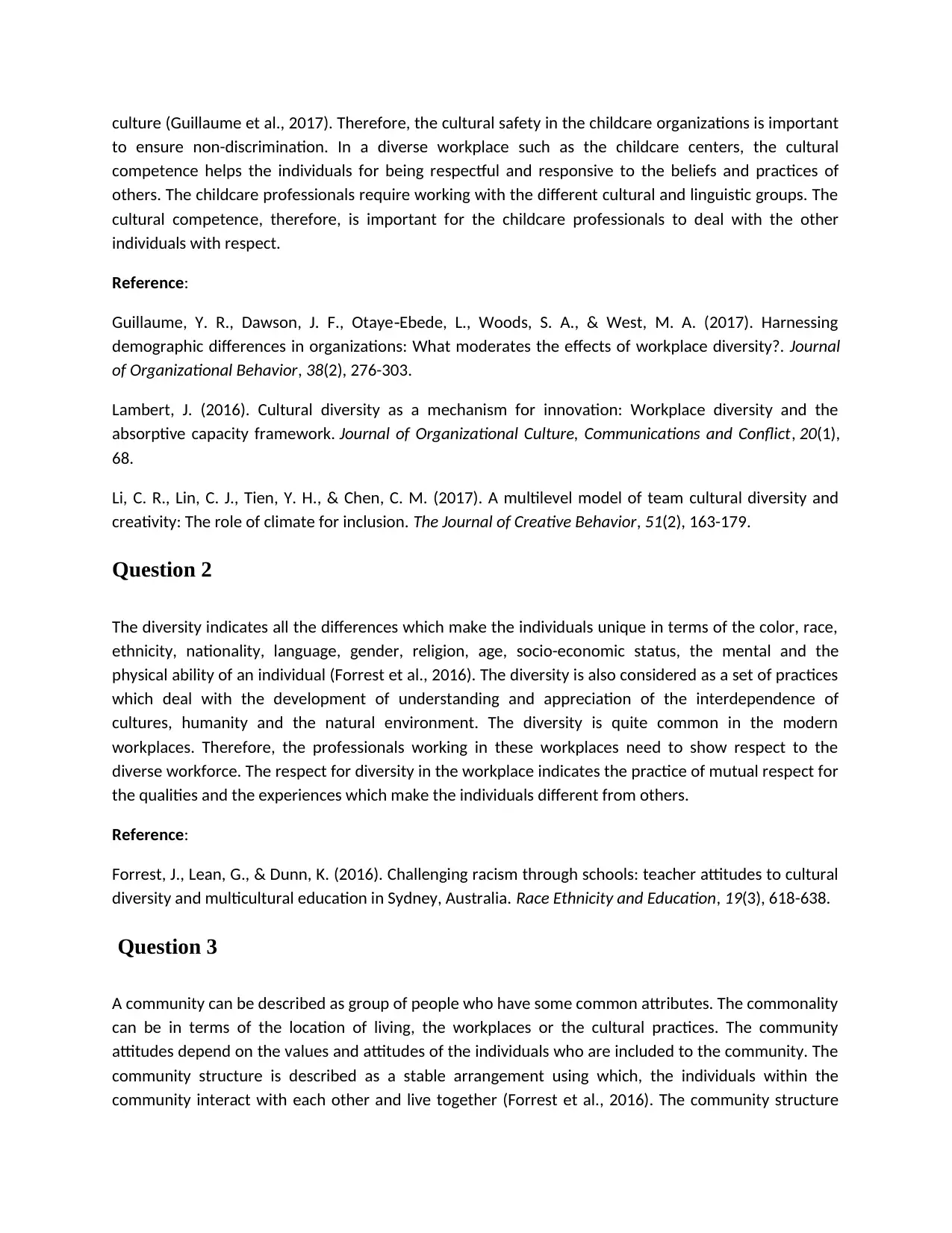
culture (Guillaume et al., 2017). Therefore, the cultural safety in the childcare organizations is important
to ensure non-discrimination. In a diverse workplace such as the childcare centers, the cultural
competence helps the individuals for being respectful and responsive to the beliefs and practices of
others. The childcare professionals require working with the different cultural and linguistic groups. The
cultural competence, therefore, is important for the childcare professionals to deal with the other
individuals with respect.
Reference:
Guillaume, Y. R., Dawson, J. F., Otaye Ebede, L., Woods, S. A., & West, M. A. (2017). Harnessing‐
demographic differences in organizations: What moderates the effects of workplace diversity?. Journal
of Organizational Behavior, 38(2), 276-303.
Lambert, J. (2016). Cultural diversity as a mechanism for innovation: Workplace diversity and the
absorptive capacity framework. Journal of Organizational Culture, Communications and Conflict, 20(1),
68.
Li, C. R., Lin, C. J., Tien, Y. H., & Chen, C. M. (2017). A multilevel model of team cultural diversity and
creativity: The role of climate for inclusion. The Journal of Creative Behavior, 51(2), 163-179.
Question 2
The diversity indicates all the differences which make the individuals unique in terms of the color, race,
ethnicity, nationality, language, gender, religion, age, socio-economic status, the mental and the
physical ability of an individual (Forrest et al., 2016). The diversity is also considered as a set of practices
which deal with the development of understanding and appreciation of the interdependence of
cultures, humanity and the natural environment. The diversity is quite common in the modern
workplaces. Therefore, the professionals working in these workplaces need to show respect to the
diverse workforce. The respect for diversity in the workplace indicates the practice of mutual respect for
the qualities and the experiences which make the individuals different from others.
Reference:
Forrest, J., Lean, G., & Dunn, K. (2016). Challenging racism through schools: teacher attitudes to cultural
diversity and multicultural education in Sydney, Australia. Race Ethnicity and Education, 19(3), 618-638.
Question 3
A community can be described as group of people who have some common attributes. The commonality
can be in terms of the location of living, the workplaces or the cultural practices. The community
attitudes depend on the values and attitudes of the individuals who are included to the community. The
community structure is described as a stable arrangement using which, the individuals within the
community interact with each other and live together (Forrest et al., 2016). The community structure
to ensure non-discrimination. In a diverse workplace such as the childcare centers, the cultural
competence helps the individuals for being respectful and responsive to the beliefs and practices of
others. The childcare professionals require working with the different cultural and linguistic groups. The
cultural competence, therefore, is important for the childcare professionals to deal with the other
individuals with respect.
Reference:
Guillaume, Y. R., Dawson, J. F., Otaye Ebede, L., Woods, S. A., & West, M. A. (2017). Harnessing‐
demographic differences in organizations: What moderates the effects of workplace diversity?. Journal
of Organizational Behavior, 38(2), 276-303.
Lambert, J. (2016). Cultural diversity as a mechanism for innovation: Workplace diversity and the
absorptive capacity framework. Journal of Organizational Culture, Communications and Conflict, 20(1),
68.
Li, C. R., Lin, C. J., Tien, Y. H., & Chen, C. M. (2017). A multilevel model of team cultural diversity and
creativity: The role of climate for inclusion. The Journal of Creative Behavior, 51(2), 163-179.
Question 2
The diversity indicates all the differences which make the individuals unique in terms of the color, race,
ethnicity, nationality, language, gender, religion, age, socio-economic status, the mental and the
physical ability of an individual (Forrest et al., 2016). The diversity is also considered as a set of practices
which deal with the development of understanding and appreciation of the interdependence of
cultures, humanity and the natural environment. The diversity is quite common in the modern
workplaces. Therefore, the professionals working in these workplaces need to show respect to the
diverse workforce. The respect for diversity in the workplace indicates the practice of mutual respect for
the qualities and the experiences which make the individuals different from others.
Reference:
Forrest, J., Lean, G., & Dunn, K. (2016). Challenging racism through schools: teacher attitudes to cultural
diversity and multicultural education in Sydney, Australia. Race Ethnicity and Education, 19(3), 618-638.
Question 3
A community can be described as group of people who have some common attributes. The commonality
can be in terms of the location of living, the workplaces or the cultural practices. The community
attitudes depend on the values and attitudes of the individuals who are included to the community. The
community structure is described as a stable arrangement using which, the individuals within the
community interact with each other and live together (Forrest et al., 2016). The community structure
Paraphrase This Document
Need a fresh take? Get an instant paraphrase of this document with our AI Paraphraser
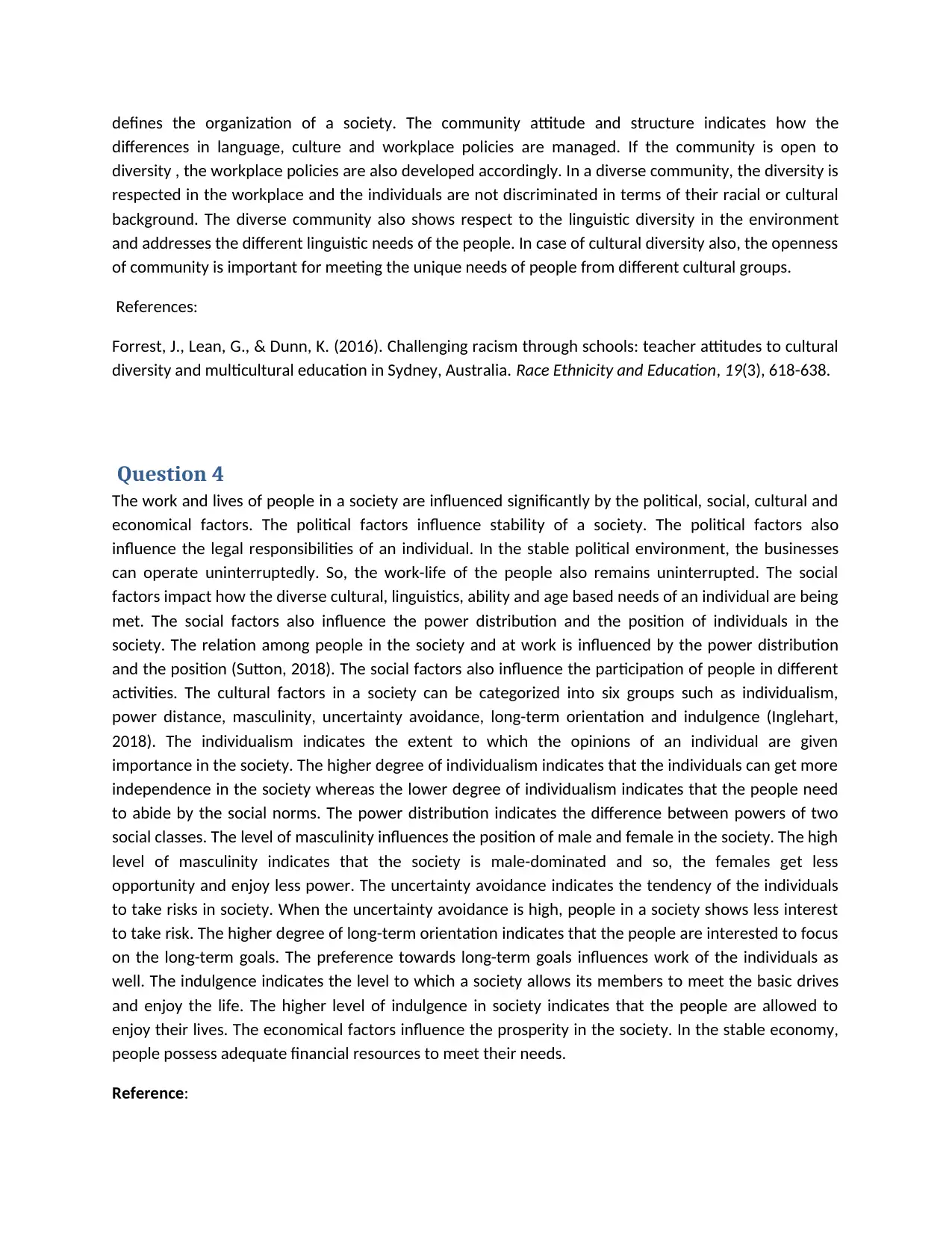
defines the organization of a society. The community attitude and structure indicates how the
differences in language, culture and workplace policies are managed. If the community is open to
diversity , the workplace policies are also developed accordingly. In a diverse community, the diversity is
respected in the workplace and the individuals are not discriminated in terms of their racial or cultural
background. The diverse community also shows respect to the linguistic diversity in the environment
and addresses the different linguistic needs of the people. In case of cultural diversity also, the openness
of community is important for meeting the unique needs of people from different cultural groups.
References:
Forrest, J., Lean, G., & Dunn, K. (2016). Challenging racism through schools: teacher attitudes to cultural
diversity and multicultural education in Sydney, Australia. Race Ethnicity and Education, 19(3), 618-638.
Question 4
The work and lives of people in a society are influenced significantly by the political, social, cultural and
economical factors. The political factors influence stability of a society. The political factors also
influence the legal responsibilities of an individual. In the stable political environment, the businesses
can operate uninterruptedly. So, the work-life of the people also remains uninterrupted. The social
factors impact how the diverse cultural, linguistics, ability and age based needs of an individual are being
met. The social factors also influence the power distribution and the position of individuals in the
society. The relation among people in the society and at work is influenced by the power distribution
and the position (Sutton, 2018). The social factors also influence the participation of people in different
activities. The cultural factors in a society can be categorized into six groups such as individualism,
power distance, masculinity, uncertainty avoidance, long-term orientation and indulgence (Inglehart,
2018). The individualism indicates the extent to which the opinions of an individual are given
importance in the society. The higher degree of individualism indicates that the individuals can get more
independence in the society whereas the lower degree of individualism indicates that the people need
to abide by the social norms. The power distribution indicates the difference between powers of two
social classes. The level of masculinity influences the position of male and female in the society. The high
level of masculinity indicates that the society is male-dominated and so, the females get less
opportunity and enjoy less power. The uncertainty avoidance indicates the tendency of the individuals
to take risks in society. When the uncertainty avoidance is high, people in a society shows less interest
to take risk. The higher degree of long-term orientation indicates that the people are interested to focus
on the long-term goals. The preference towards long-term goals influences work of the individuals as
well. The indulgence indicates the level to which a society allows its members to meet the basic drives
and enjoy the life. The higher level of indulgence in society indicates that the people are allowed to
enjoy their lives. The economical factors influence the prosperity in the society. In the stable economy,
people possess adequate financial resources to meet their needs.
Reference:
differences in language, culture and workplace policies are managed. If the community is open to
diversity , the workplace policies are also developed accordingly. In a diverse community, the diversity is
respected in the workplace and the individuals are not discriminated in terms of their racial or cultural
background. The diverse community also shows respect to the linguistic diversity in the environment
and addresses the different linguistic needs of the people. In case of cultural diversity also, the openness
of community is important for meeting the unique needs of people from different cultural groups.
References:
Forrest, J., Lean, G., & Dunn, K. (2016). Challenging racism through schools: teacher attitudes to cultural
diversity and multicultural education in Sydney, Australia. Race Ethnicity and Education, 19(3), 618-638.
Question 4
The work and lives of people in a society are influenced significantly by the political, social, cultural and
economical factors. The political factors influence stability of a society. The political factors also
influence the legal responsibilities of an individual. In the stable political environment, the businesses
can operate uninterruptedly. So, the work-life of the people also remains uninterrupted. The social
factors impact how the diverse cultural, linguistics, ability and age based needs of an individual are being
met. The social factors also influence the power distribution and the position of individuals in the
society. The relation among people in the society and at work is influenced by the power distribution
and the position (Sutton, 2018). The social factors also influence the participation of people in different
activities. The cultural factors in a society can be categorized into six groups such as individualism,
power distance, masculinity, uncertainty avoidance, long-term orientation and indulgence (Inglehart,
2018). The individualism indicates the extent to which the opinions of an individual are given
importance in the society. The higher degree of individualism indicates that the individuals can get more
independence in the society whereas the lower degree of individualism indicates that the people need
to abide by the social norms. The power distribution indicates the difference between powers of two
social classes. The level of masculinity influences the position of male and female in the society. The high
level of masculinity indicates that the society is male-dominated and so, the females get less
opportunity and enjoy less power. The uncertainty avoidance indicates the tendency of the individuals
to take risks in society. When the uncertainty avoidance is high, people in a society shows less interest
to take risk. The higher degree of long-term orientation indicates that the people are interested to focus
on the long-term goals. The preference towards long-term goals influences work of the individuals as
well. The indulgence indicates the level to which a society allows its members to meet the basic drives
and enjoy the life. The higher level of indulgence in society indicates that the people are allowed to
enjoy their lives. The economical factors influence the prosperity in the society. In the stable economy,
people possess adequate financial resources to meet their needs.
Reference:
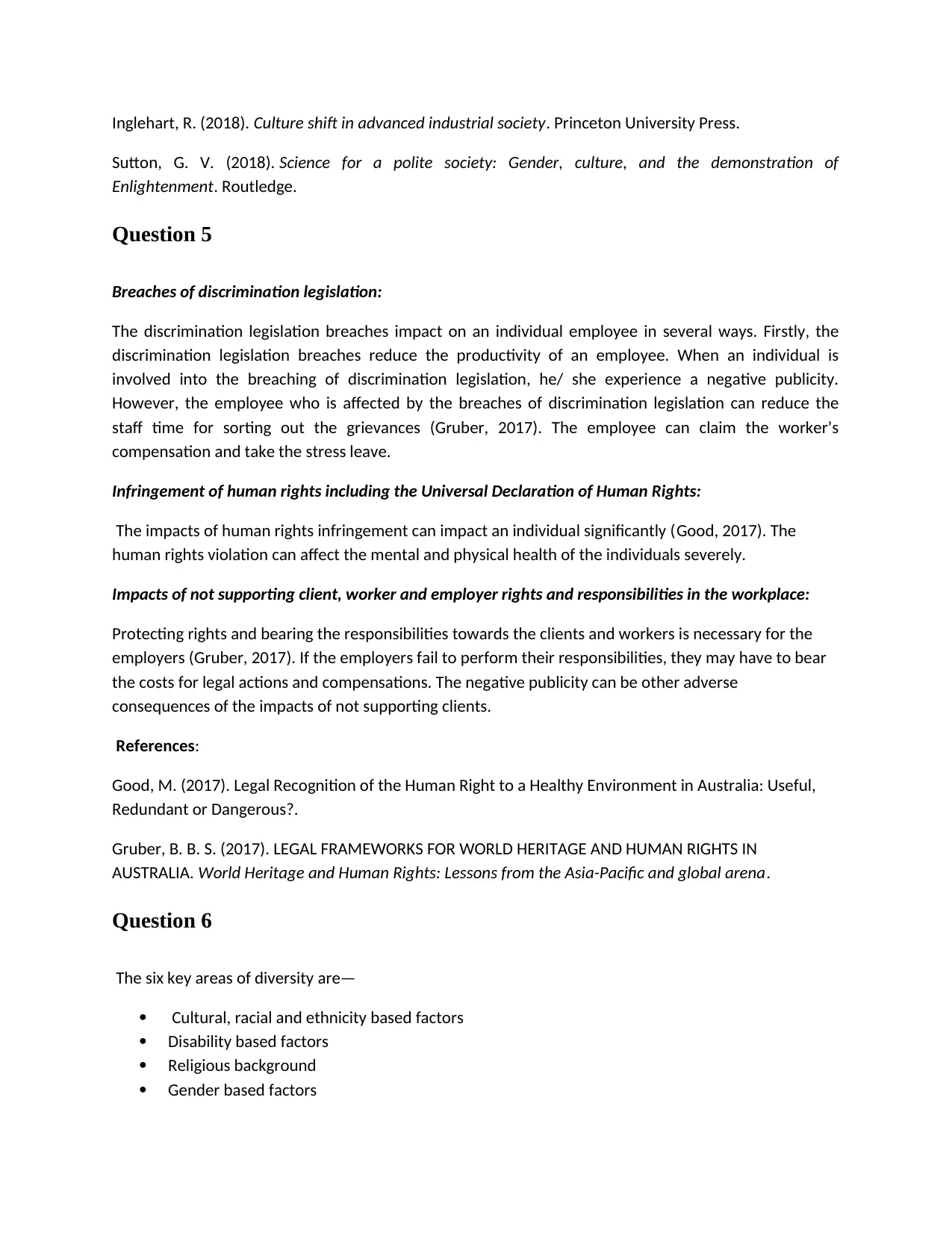
Inglehart, R. (2018). Culture shift in advanced industrial society. Princeton University Press.
Sutton, G. V. (2018). Science for a polite society: Gender, culture, and the demonstration of
Enlightenment. Routledge.
Question 5
Breaches of discrimination legislation:
The discrimination legislation breaches impact on an individual employee in several ways. Firstly, the
discrimination legislation breaches reduce the productivity of an employee. When an individual is
involved into the breaching of discrimination legislation, he/ she experience a negative publicity.
However, the employee who is affected by the breaches of discrimination legislation can reduce the
staff time for sorting out the grievances (Gruber, 2017). The employee can claim the worker’s
compensation and take the stress leave.
Infringement of human rights including the Universal Declaration of Human Rights:
The impacts of human rights infringement can impact an individual significantly (Good, 2017). The
human rights violation can affect the mental and physical health of the individuals severely.
Impacts of not supporting client, worker and employer rights and responsibilities in the workplace:
Protecting rights and bearing the responsibilities towards the clients and workers is necessary for the
employers (Gruber, 2017). If the employers fail to perform their responsibilities, they may have to bear
the costs for legal actions and compensations. The negative publicity can be other adverse
consequences of the impacts of not supporting clients.
References:
Good, M. (2017). Legal Recognition of the Human Right to a Healthy Environment in Australia: Useful,
Redundant or Dangerous?.
Gruber, B. B. S. (2017). LEGAL FRAMEWORKS FOR WORLD HERITAGE AND HUMAN RIGHTS IN
AUSTRALIA. World Heritage and Human Rights: Lessons from the Asia-Pacific and global arena.
Question 6
The six key areas of diversity are—
Cultural, racial and ethnicity based factors
Disability based factors
Religious background
Gender based factors
Sutton, G. V. (2018). Science for a polite society: Gender, culture, and the demonstration of
Enlightenment. Routledge.
Question 5
Breaches of discrimination legislation:
The discrimination legislation breaches impact on an individual employee in several ways. Firstly, the
discrimination legislation breaches reduce the productivity of an employee. When an individual is
involved into the breaching of discrimination legislation, he/ she experience a negative publicity.
However, the employee who is affected by the breaches of discrimination legislation can reduce the
staff time for sorting out the grievances (Gruber, 2017). The employee can claim the worker’s
compensation and take the stress leave.
Infringement of human rights including the Universal Declaration of Human Rights:
The impacts of human rights infringement can impact an individual significantly (Good, 2017). The
human rights violation can affect the mental and physical health of the individuals severely.
Impacts of not supporting client, worker and employer rights and responsibilities in the workplace:
Protecting rights and bearing the responsibilities towards the clients and workers is necessary for the
employers (Gruber, 2017). If the employers fail to perform their responsibilities, they may have to bear
the costs for legal actions and compensations. The negative publicity can be other adverse
consequences of the impacts of not supporting clients.
References:
Good, M. (2017). Legal Recognition of the Human Right to a Healthy Environment in Australia: Useful,
Redundant or Dangerous?.
Gruber, B. B. S. (2017). LEGAL FRAMEWORKS FOR WORLD HERITAGE AND HUMAN RIGHTS IN
AUSTRALIA. World Heritage and Human Rights: Lessons from the Asia-Pacific and global arena.
Question 6
The six key areas of diversity are—
Cultural, racial and ethnicity based factors
Disability based factors
Religious background
Gender based factors
⊘ This is a preview!⊘
Do you want full access?
Subscribe today to unlock all pages.

Trusted by 1+ million students worldwide
1 out of 23
Related Documents
Your All-in-One AI-Powered Toolkit for Academic Success.
+13062052269
info@desklib.com
Available 24*7 on WhatsApp / Email
![[object Object]](/_next/static/media/star-bottom.7253800d.svg)
Unlock your academic potential
Copyright © 2020–2025 A2Z Services. All Rights Reserved. Developed and managed by ZUCOL.





